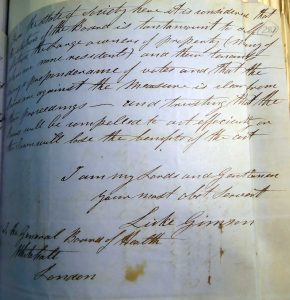Plans, not Actions
In January 1850 Loughborough was placed under the Public Health Act, requiring a Local Board to be elected and to act on the recommendations made. The election was strongly contested. One local paper described the candidates as standing for the “do nothing” party, the “movers”, who wanted to implement William Lee’s recommendations in full, and the “something must be done” party, who wished to steer a middle course. A board was elected in March 1850, but the majority of votes were cast by non-resident owners of land and property (who would be paying much of the cost, but gain no benefit) and their tenants.
The Board appointed George Stevenson as its surveyor. He was a civil engineer but a stranger to Loughborough. He had given his pledge to the board that he would oppose a scheme for a water supply if, on better acquaintance with the town, he deemed it unnecessary, and he agreed to accept a fixed salary which was insufficient to allow any time to supervise the building of a waterworks and the laying of pipes.

After examining the town, Stevenson found himself in favour of ‘an abundant and constant supply of water under considerable pressure’. The Board responded to his recommendation by seeking a second opinion from another engineer, Thomas Hawkesley of Nottingham. Hawkesley was a very able man, but a very busy one, and 12 months elapsed before he reported back.
Meanwhile, Luke Gimson, who employed 300 people in his hosiery factory on Ashby Road, complained to the Board of Health in London about the “fixed determination of certain members to procrastinate and prevent as much as possible the Public Health Act being usefully brought into operation”.
Stevenson was replaced as surveyor by the appointment of Charles Tebbutt. Revd Fearon was also becoming restless. Fearon and Revd Bunch, the rector of Emmanuel Church, wrote a joint letter to the local board in May 1852, which they copied to local newspapers, drawing attention to the high level of mortality in the town, and the urgent need for sanitary improvements.
Hawkesley’s recommendations, received by the board in August 1852, were for a system of sewerage, and the replacement of wells by piped water under pressure, to be taken from the Black Brook. The water was essential for flushing waste through the sewerage system. He estimated that the total cost would be under £20,000. The board accepted his recommendations, and approved a resolution to implement them.
It was another 7 months before Tebbutt produced his proposals for a system of drainage, which would cost £7,250. These were approved by the board. No plans were produced for a water supply.
